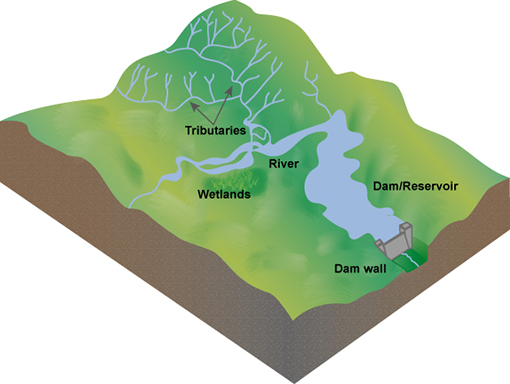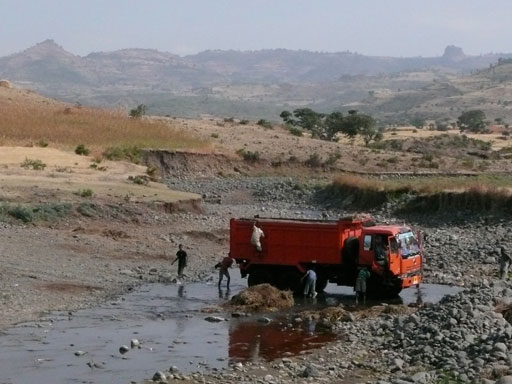4.1 Pathways of water pollution
Pollution can be defined as the introduction into the natural environment (air, water or land) of substances (pollutants) that are liable to cause harm to human health or to animals, plants and the wider environment. Water pollution occurs when surface water or groundwater is adversely affected by the addition of pollutants.
For surface water, the quality of the water will be determined by the geology, by precipitation and by what happens in the catchment. The catchment of a river is the total area of surrounding land that slopes towards the river (Figure 4.1). Rainwater that lands in a catchment flows into the river. River water can be contaminated from pollution sources in the catchment even though they may be some distance away. Protecting surface water from pollution is difficult because the activities of upstream users of river water will affect the quality of the water for downstream users. For groundwater, the situation is similar but the boundaries are less distinct and pollutants can seep into aquifers that extend below more than one catchment.

Water quality can be affected by pollution from point sources and non-point sources. Point sources are identifiable locations (such as a factory, often with a pipe or channel leading from them) that discharge directly into a body of surface water. Groundwater is also affected by point sources where contaminants seep into the soil and rock from an identifiable source, for example, underground fuel tanks, septic tanks or pit latrines. Non-point sources are those where pollution arises over a wide area and it is often difficult to locate the exact place of origin. For example, fertiliser or pesticide that has been widely spread may be washed from a field by rain into a river or stream at many places, or seep into groundwater. It is pollution from non-point sources, also known as diffuse pollution, that contributes most of the contaminants in surface and groundwater. The problems in identifying the exact point of origin make non-point sources much more difficult to control.
Look at Figure 4.2. What pollutants are likely to be washed into the river from the lorry? Is this a point source or non-point source of pollution?
Dust and dirt from the lorry will be washed into the river. Some oil and fuel may also be washed from the underside. The lorry is the single source of pollution, so this is an example of a point source.

The normal flow of river water can reduce the impact of some pollutants. When contaminated river water moves downstream it is possible that any pollutant will be diluted as more water flows in and so increases the total volume of water in the river. This dilution may be enough to reduce the concentration of the contaminants sufficiently to minimise the possible impacts, but this depends on several factors, including the quantity and type of pollutant, and the volume and flow rate of the river.
Learning Outcomes for Study Session 4
